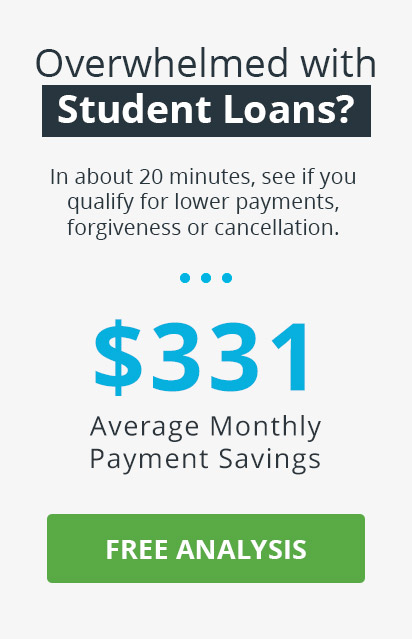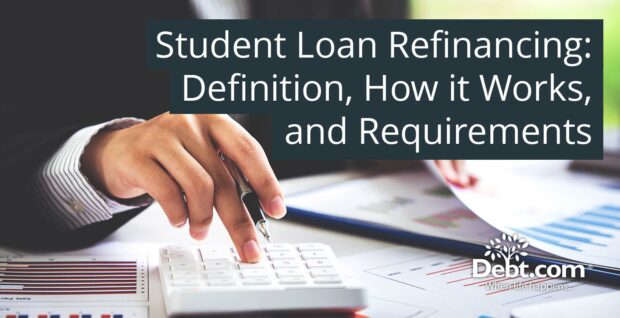IMPORTANT UPDATE: The Department of Education has begun collections on defaulted student loans. Reporting shows the federal government “can seize tax refunds, paychecks, and Social Security beneftis.” Trump administration says “number in default can double from 5 million to 10 million within in a few months.”
For More »

Table of Contents
What happens when you default on student loans?
Falling behind on student loan payments doesn’t just bring stress—it opens the door for serious financial consequences. After nine months of missed payments, your federal loans are labeled as “in default,” and that’s when things can really escalate.
The government can legally step in to take your money. We’re talking wage garnishment, seizing your tax refunds, or even dipping into your Social Security checks if you’re receiving them. It happens fast, often without a court appearance, and can leave you feeling blindsided. But here’s the good news: you’ve got options—but acting quickly is key.
How fast can they garnish your wages or taxes?
If your loan payments are overdue for 270 days (or 330 for less frequent payments), you’re officially in default. From there, the Department of Education only needs to give you a 30-day heads-up before collections start. No judge. No hearing. Just a notice in your inbox or mailbox.
Don’t wait to respond. If you miss that 30- day window, you’ll be hit with consequences quickly. Your paycheck shrinks. That tax refund you were counting on? Gone. It’s a harsh wake-up call, especially for borrowers juggling multiple responsibilities.
3 ways the government can take your money
If you fail to take action on your defaulted federal student loans, the government has several powerful tools to recover the debt directly from you. These aren’t optional deductions; they are legal actions the government can take without your consent.
1. Wage garnishment
Wage garnishment means the government takes up to 15% of your disposable income straight from your paycheck. You don’t get to approve it—your employer is required to comply. If you’re already living paycheck to paycheck, this can push you from tight to impossible. Many borrowers only find out it’s happening after their paycheck is noticeably lighter.
2. Tax refund intercept
If your loans are in default, the government can take your entire federal tax refund. This can happen as soon as you file your taxes after the default occurs. There’s no way to delay or negotiate this process, so any refund you anticipate receiving could be directly applied to your defaulted loan balance.
3. Federal salary offset
Work for the federal government? Then you’re doubly at risk. Through salary offset, the government can take 15% of your disposable pay—even if you’ve already got other garnishments. And if you’re receiving Social Security, those benefits can also be partially withheld.
Give us 20 minutes. We’ll give you a personalized plan to reduce your student loans – possibly by hundreds a month.
When most people hear the term garnish, they may think about parsley on the side of a dinner plate. That’s not the garnishment we’re talking about. This garnishment will make you lose your appetite.
Student loan garnishment means that the government takes a chunk of your paycheck or your tax returns. The government then uses that money, your money, to pay down your student loans. Thankfully, this only happens when you are in default. That’s when you fail to make money payments for 9 consecutive months.
At that point, the government goes after your cash and it’s totally legal. How much can they take? Up to 15% of every paycheck and all of your tax refunds. This is definitely something you want to avoid. Luckily, there are proven ways to grind garnishment to a halt. Learn about them at Debt.com.
How to stop student Loan garnishment before it starts
The good news is you have the power to prevent wage garnishment and other aggressive collection actions before they begin. The key is to take proactive steps to address your defaulted federal student loans now, before the government initiates these measures. Here’s what you can do:
Contact the default resolution group immediately
Reach out to the Department of Education’s Default Resolution Group as soon as possible. They can explain your specific situation and outline the available options to get out of default.
Enroll in an income-driven repayment plan
Income-driven repayment plans (IDRs) are like a financial reset button. These plans base your monthly payment on your income and family size and can significantly lower your payments, making them more manageable and helping you avoid default in the future. Some borrowers even qualify for $0 monthly payments. Enrolling in an IDR stops garnishment in its tracks and starts rebuilding your financial footing. It’s a lifeline worth exploring.
Rehabilitate or consolidate your loans
- Loan rehabilitation: This involves making nine affordable monthly payments over ten consecutive months. Successfully rehabilitating your loan removes the default status from your credit report and stops collection actions like garnishment.
- Loan consolidation: If rehab isn’t a fit, consolidation might be. By consolidating your defaulted federal student loans into a new Direct Consolidation Loan, you can potentially stop current collection efforts. However, you’ll typically need to agree to repay the new loan under an income-driven repayment (IDR) plan or make a certain number of payments beforehand.
Adjust your tax withholding
If you typically receive a large tax refund, consider adjusting your W-4 with your employer to spread that money into your paychecks throughout the year. This small change increases your immediate cash flow, providing more funds that could be used to address your defaulted student loans. Additionally, a smaller expected refund reduces the potential impact of a tax refund intercept. However, it’s important to understand that adjusting your withholding is a supplementary strategy for managing your finances and does not resolve your loan default or stop other collection actions like wage garnishment. You still need to actively pursue solutions like loan rehabilitation, consolidation, or income-driven repayment plans through the Department of Education’s Default Resolution Group.
Can you be garnished for multiple debts?
Short answer: yes. If you owe child support, unpaid taxes, or other federal debts, the garnishments can stack up. While the law usually limits garnishments to 25% of your disposable income, exceptions can push that number higher.
If your budget is squeezed past the breaking point, don’t wait. Reach out to a nonprofit credit counselor or legal aid service. They can help you figure out what’s being taken, what can be negotiated, and what relief options exist.
How to stop student loan garnishment
Question: I just received a letter stating my student loan that has been in default is to be offset. I am working. I’m also already facing wage garnishment for child support arrears. I barely make $11,000 a year and they garnish $300 each month for my arrears.
My question is: Can the government garnish my wages at the same time garnishment for my arrears ? Or will they wait until I pay my arrears off? If they don’t do that, I won’t have anything left to live on!
— Angie in Texas
Steve Rhode answers…
You are living through a tremendously stressful situation with your student loan debt, Angie. I wish I could wave a wand and make that pressure from the Federal Government vanish. What I can offer you is good information about how to stop student loan garnishment and a plan forward.
1. Look into an offset
An offset is typically a tax refund intercept, unless you’re also getting federal benefits like Social Security. The tax refund intercept is easy to deal with — just don’t get tax refunds. You should adjust your withholding, if any, to get more money in your pocket each month and not in a refund check. Thus, you can avoid the IRS intercept and you’ll have more money to cover your expenses each month.
2. Repayment plans
Now that’s a short-term solution. For more of a long-term solution on the federal loans, you can get into a $0 monthly payment plan that will prevent you from having defaulted loans. In fact, I just recently answered a reader question that dealt with this.
I’m not an attorney. You’d need to speak to an attorney licensed in Texas for specific legal advice, but it appears in Texas you can have up to a wage garnishment that’s up to 25 percent of your disposable income — but not more than 30 times the minimum wage.
If you did get a federal student loan wage garnishment, it would come in the form of a letter and be called an “Administrative Wage Garnishment.” Open it. The letter will instruct you on how to appeal the garnishment to hopefully get it suspended.
3. Modification
Texas will allow you to modify your mandatory child support garnishment if you can demonstrate the garnishment doesn’t allow you sufficient income to live on. To modify how much they garnish your wages, talk to the court or a licensed attorney in Texas. Another solution may be to look into debt consolidation, which can include child support arrears.
FAQs about garnishment
Here are some common follow up questions you may have:
Garnishment lasts until the loan is completely re-paid, rehabilitated, or consolidated. It doesn’t stop just because things get tough—you’ve got to take action to change the outcome.
They can—but only after suing you and winning in court. That gives you more time to prepare, but don’t ignore the problem. If they win, they can take a chunk of your paycheck, too.
Yes. Defaults and garnishments tank your credit score and stay on your report for up to seven years. That can affect everything from renting an apartment to getting a job.
Update: Millions face garnishment starting May 2025
The U.S. Department of Education is restarting collections on defaulted loans starting May 5, 2025. After a four-year pause due to COVID-19.
That means if you’re in default, expect to see:
- Wage garnishment
Seized tax refunds
Social Security and federal salary deductions
By the numbers:
- Over 5 million borrowers are already in default.
Another 4 million are close to falling in.
Less than 40% of borrowers are actively making payments.
What’s coming:
The Department of Education is currently sending out warning emails. Official wage garnishment notices will likely follow by this summer. Don’t wait until you receive one of these formal notices – by then, it may be too late to easily prevent the garnishment from starting. Act now by contacting the Department of Education’s Default Resolution Group to explore your options.
Bigger picture:
The repayment pause officially ended in October 2024, but not everyone has resumed payments. While targeted forgiveness has helped some borrowers, broad debt cancellation isn’t on the table. According to the press release from the Department of Education “There will not be any mass loan forgiveness. We will help borrowers return to repayment—for their financial health and the nation’s economic outlook.”
If you’re struggling, you’re not alone—and resources are available to help you like the Department of Education’s Default Resolution Group, StudentAid.gov, and credit counselors.
Your plan to stop wage garnishment starts now
Don’t let wage garnishment take control of your finances. If you’re struggling with student loan debt or facing default, know that you’re not alone, and help is available through resources like the Department of Education’s Default Resolution Group, StudentAid.gov, and credit counselors. Now is the time to act. Take that first step – whether it’s contacting your servicer, exploring IDR, rehab, or consolidation – to change your financial future. For personalized support, call us at [phone-number] to speak with someone who understands your situation and can help you create a plan.











